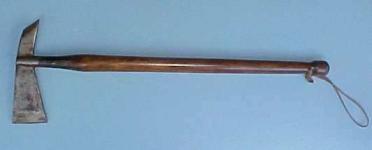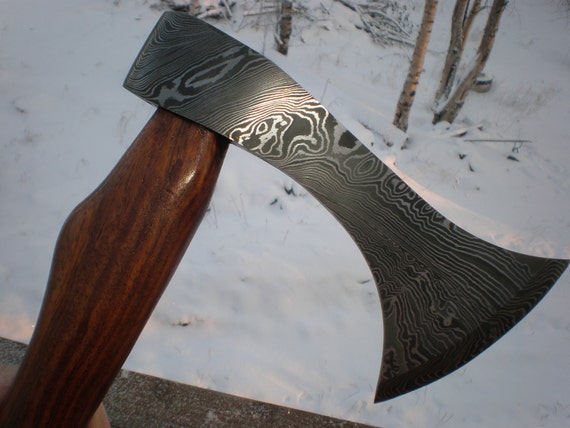
 |
|
|
|
|
#1 |
|
(deceased)
Join Date: Dec 2004
Location: Portugal
Posts: 9,694
|
Outstanding input Gentlemen,
We sure have in this forum some 'inmates' that can talk a great deal about (boarding) axes. |
|
|

|
|
|
#2 |
|
Member
Join Date: Dec 2004
Location: NC, U.S.A.
Posts: 2,097
|
http://web.prm.ox.ac.uk/weapons/inde...our-europe-154
Note the end shape of the haft compared to our example. |
|
|

|
|
|
#3 |
|
Member
Join Date: Mar 2006
Location: Room 101, Glos. UK
Posts: 4,183
|
the side langets are an english affectation.
 i suspect the axe posted by mr. eley is an english copy of a french one. the std. english broad arrow ones tended to being more angular, wedge-like with straighter lines and a straighter edge. they, generally had a ball ended haft too. i suspect the axe posted by mr. eley is an english copy of a french one. the std. english broad arrow ones tended to being more angular, wedge-like with straighter lines and a straighter edge. they, generally had a ball ended haft too.early 19th c. royal navy pattern (nelsonian)  french boarding axe:  note the fore-aft rather than side langets, and the haft end is more pry-like. just to complexicate things, american fire axe presented after the great fire in hoboken, NJ (1900)  note the lack of langets. my everyday axe just for drool factor  
Last edited by kronckew; 2nd February 2013 at 05:45 PM. |
|
|

|
|
|
#4 |
|
Member
Join Date: Jan 2013
Location: Scotland
Posts: 330
|
Excellent pictures Kronckew and I think I agree with you that the French have the edge when it comes to the elegance factor.
I know it's not a hundred percent conclusive but until anyone says different, it's in my collection as an early 19th century (possibly)French boarding axe. Many thanks to you both. |
|
|

|
|
|
#5 |
|
Member
Join Date: Dec 2004
Location: NC, U.S.A.
Posts: 2,097
|
You are a lucky man! I love your ax. I, unfortunately, only have one true boarding ax in my collection and have been wanting one of these French types. Forgot to mention that the eye on yours is squared, another popularity with the French patterns.
Thank you, Kronckew, for posting the pics. I'm not so savvy when it comes to such things-  . Yes, I did notice that the one I mentioned was British, but of the French pattern. Forgot to mention that and hope it didn't cause any confusion. It is interesting that the boarding axe, serving as both a weapon and tool, became the standard fire ax as we know it. It goes back to the fact that on the crowded decks of ships, almost anything could become a weapon in a hand-to-hand melee (whaling blubber knives, belaying pins, axes, rope and tackle, rumlets, grappling hooks, etc, etc). The trick is deciding when is an ax a weapon and when is it just a fire suppressant? . Yes, I did notice that the one I mentioned was British, but of the French pattern. Forgot to mention that and hope it didn't cause any confusion. It is interesting that the boarding axe, serving as both a weapon and tool, became the standard fire ax as we know it. It goes back to the fact that on the crowded decks of ships, almost anything could become a weapon in a hand-to-hand melee (whaling blubber knives, belaying pins, axes, rope and tackle, rumlets, grappling hooks, etc, etc). The trick is deciding when is an ax a weapon and when is it just a fire suppressant?
|
|
|

|
|
|
#6 | |
|
Member
Join Date: Mar 2006
Location: Room 101, Glos. UK
Posts: 4,183
|
Quote:
that went out of fashion as the fire activity predominated. and boarding actions became rare. sadly, with attacks on responding fireman increasing, it may see use as a weapon again. even boarding activity at sea is on the increase. pirates might get a surprise! they're already using firehoses to wash them off ladders... |
|
|
|

|
 |
| Thread Tools | Search this Thread |
| Display Modes | |
|
|